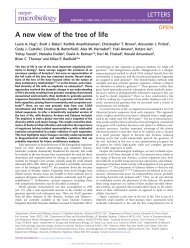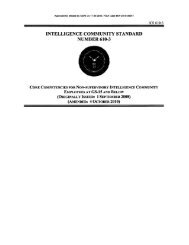The Joint Force in a Contested and Disordered World
JCS-JOE-2035
JCS-JOE-2035
Create successful ePaper yourself
Turn your PDF publications into a flip-book with our unique Google optimized e-Paper software.
members with<strong>in</strong> the United States itself as adversaries improve their ability to match onl<strong>in</strong>e<br />
personas with physical locations. As a result, the need to develop new narratives <strong>and</strong> novel<br />
depolarization techniques favorable to the United States will become more critical.<br />
New manufactur<strong>in</strong>g capabilities comb<strong>in</strong>ed with an emerg<strong>in</strong>g ability to program <strong>in</strong>expensive <strong>and</strong><br />
widely available computer processors may allow identity networks to rapidly build <strong>and</strong> field<br />
sophisticated weapons that may not require sophisticated users to effectively employ. Greater<br />
access to sophisticated weaponry will enable small unit, distributed attacks; raid<strong>in</strong>g over wide<br />
areas; the disruption or destruction of forward operat<strong>in</strong>g bases <strong>and</strong> embassies; <strong>and</strong> the target<strong>in</strong>g of<br />
key <strong>in</strong>frastructure, cultural monuments, schools, hospitals, places of worship, or military personnel<br />
<strong>and</strong> their families with<strong>in</strong> the United States <strong>and</strong> liv<strong>in</strong>g abroad.<br />
Furthermore, <strong>in</strong>stead of one-off affairs, terrorist attacks <strong>in</strong> the future might become coord<strong>in</strong>ated<br />
<strong>and</strong> susta<strong>in</strong>ed campaigns with rapidly shift<strong>in</strong>g methods <strong>and</strong> targets. <strong>The</strong> cont<strong>in</strong>u<strong>in</strong>g spread of<br />
technology will provide greater opportunities for potential adversaries to design, resource, <strong>and</strong><br />
execute complex attacks <strong>and</strong> comb<strong>in</strong>e many complex attacks <strong>in</strong>to larger, more susta<strong>in</strong>ed<br />
campaigns. For example, simultaneous multi-city <strong>and</strong> multi-location operations might <strong>in</strong>volve<br />
coord<strong>in</strong>ated small unit assaults, improvised <strong>and</strong> <strong>in</strong>telligent explosive device placements, <strong>and</strong> sniper<br />
attacks.<br />
<strong>The</strong> basic asymmetry at play <strong>in</strong> this context is that while identity networks have few visible targets<br />
or <strong>in</strong>frastructure to defend, the United States, its allies <strong>and</strong> partners often have expensive <strong>and</strong> hardto-replace<br />
<strong>in</strong>frastructure <strong>and</strong> culturally or politically important symbols that can be easily attacked.<br />
As such, it can be difficult to deter adversaries <strong>and</strong> br<strong>in</strong>g decisive military power to bear aga<strong>in</strong>st<br />
them. Additionally, these networks may be able to force the United States to dedicate <strong>in</strong>creas<strong>in</strong>gly<br />
scarce resources on expensive defensive measures, rather than global power projection<br />
capabilities.<br />
Context 2: Threatened U.S. Territory <strong>and</strong> Sovereignty<br />
<strong>The</strong> United States consists of 50 states <strong>and</strong> 14 adm<strong>in</strong>istered territories, <strong>in</strong>clud<strong>in</strong>g coastal waters,<br />
maritime exclusive economic zones, <strong>and</strong> airspaces (up to sixty miles) adjacent or contiguous to its<br />
territory. Defense of the United States is not just protection of the physical <strong>in</strong>tegrity of this territory,<br />
but also the protection of U.S. citizens <strong>and</strong> critical <strong>in</strong>frastructure. 18 <strong>The</strong> United States has endured<br />
attacks <strong>and</strong> raids on its territory <strong>in</strong> the past. Among others, these have <strong>in</strong>cluded the burn<strong>in</strong>g of<br />
Wash<strong>in</strong>gton, D.C. by <strong>in</strong>vad<strong>in</strong>g British forces <strong>in</strong> 1814, the surprise attack on Pearl Harbor <strong>in</strong> 1941,<br />
<strong>and</strong> the terrorist attacks on New York <strong>and</strong> Wash<strong>in</strong>gton <strong>in</strong> 2001. All underscore the endur<strong>in</strong>g<br />
requirement for military capabilities <strong>and</strong> operational approaches to physically defend U.S.<br />
sovereign territory <strong>and</strong> citizenry aga<strong>in</strong>st a wide<br />
range of foreign military operations. In 2035, the<br />
United States will confront an <strong>in</strong>creas<strong>in</strong>g number<br />
of state <strong>and</strong> non-state actors with the will <strong>and</strong><br />
capabilities to threaten targets with<strong>in</strong> the<br />
homel<strong>and</strong> <strong>and</strong> U.S. citizens with the ultimate<br />
<strong>in</strong>tention to coerce.<br />
18<br />
<strong>Jo<strong>in</strong>t</strong> Publication 3-27, Homel<strong>and</strong> Defense, (29 July 2013), p. I-1.<br />
24











